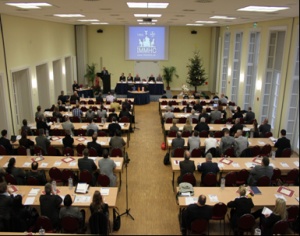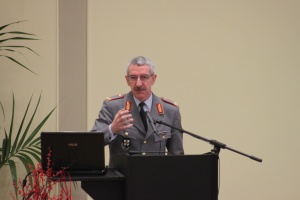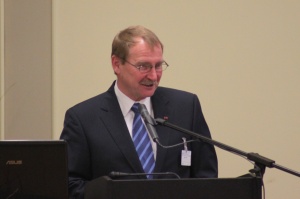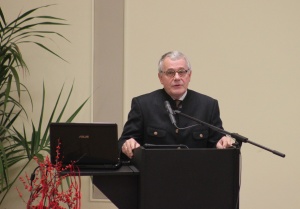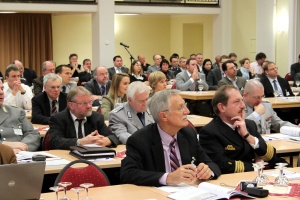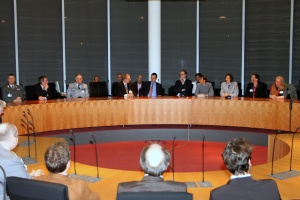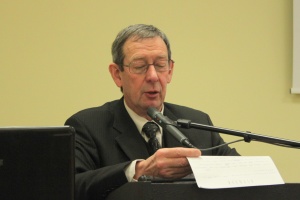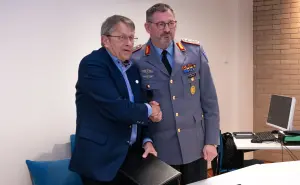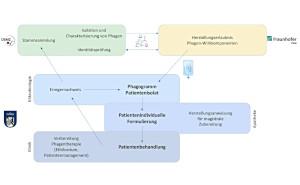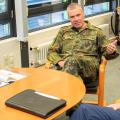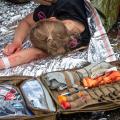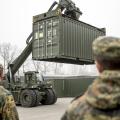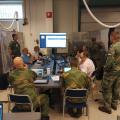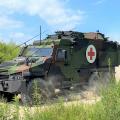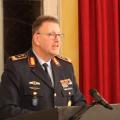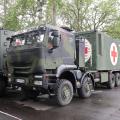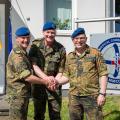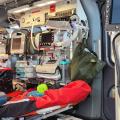14. INTERNATIONAL MILITARY MENTAL HEALTH CONFERENCE (IMMHC) IN BERLIN
Dr. Robin Hauffa, Oberstabarzt, PTZ Bundeswehrkrankenhaus BERLIN; Frank Eggen, Hauptfeldwebel, PTZ Bundeswehrkrankenhaus BERLIN
In der Zeit vom 5. bis 8. Dezember 2011 fand die 14. IMMHC, veranstaltet durch die Deutsche Gesellschaft für Wehrmedizin und Wehrpharmazie (DGWMP) e. V., in der Julius-Leber-Kaserne, Berlin statt. Fachlich geleitet wurde die Konferenz durch das seit Mai 2010 am Bundeswehrkrankenhaus Berlin eingerichtete Psychotraumazentrum (PTZ).
In der Zeit vom 5. bis 8. Dezember 2011 fand die 14. IMMHC, veranstaltet durch die Deutsche Gesellschaft für Wehrmedizin und Wehrpharmazie (DGWMP) e. V., in der Julius-Leber-Kaserne, Berlin statt (Abb. 1). Fachlich geleitet wurde die Konferenz durch das seit Mai 2010 am Bundeswehrkrankenhaus Berlin eingerichtete Psychotraumazentrum (PTZ). Ziel der jährlich stattfindenden Konferenz war es, Erfahrungen zu den Themen Prävention und Betreuung von Soldatinnen und Soldaten in einem interdisziplinären Forum aus Militärs und Wissenschaftlern zu diskutieren.
Die Veranstaltung wurde mit Grußworten des Beauftragten für PTBS, Brigadegeneral Christof Munzlinger (Abb 2), des Leiters des Psychologischen Dienstes der Bundeswehr, Ministerialrat Günter Kreim (Abb 3), und des Vorsitzenden der DGWMP, Generalarzt a. D. Dr. Christoph Veit (Abb 4), eröffnet. Den 130 Gästen aus 13 Nationen wurde unter dem Motto „Special treatment for special groups“ eine Vielzahl hochkarätiger Fachvorträge geboten. Den Anfang machte der Sprecher des Wissenschaftlichen Beirates des Psychotraumazentrums, Priv.- Doz. Dr. Dr. Niels Bergemann, Ärztlicher Direktor und Chefarzt der Schön Klinik, Bad Arolsen, mit seinem Vortrag zu eviWehrmed. Mschr. 56 (2012), Heft 7/2012 183 denzbasierten Behandlungsstrategien bei posttraumatischen Belastungsstörungen. Dabei ging er besonders auf die Wirksamkeit von psychologischen und pharmakologischen Therapieansätzen ein und unterstrich die Notwendigkeit weiterer randomisierter klinischer Studien. Anschließend berichtete Prof. Dr. Andreas Heinz, Chefarzt der Klinik für Psychiatrie und Psychotherapie an der Charité, Berlin, über die große Lücke zwischen dem Behandlungsbedarf bei psychischen Störungen und der Versorgungsrealität in Afghanistan. Insbesondere langfristige Traumatisierungsfolgen spielen in dem seit Jahrzehnten vom Krieg gezeichneten Land eine große Rolle.
Die zweite Sitzung beschäftigte sich mit neurobiologischen Markern für einsatzbedingte Erkrankungen (Abb 5). Neben aufwendigen EEG-Untersuchungen zum Zusammenhang von PTBS-Symptomen und Signalverarbeitung wurden aktuelle Untersuchungen zu neuartigen Biomarkern und Pharmaka sowie der Forschungsstand zu strukturellen und funktionellen Bildgebung vorgestellt.
Ein Höhepunkt der Veranstaltung war die Sitzung zum Thema einsatzbedingter psychischer Störung.
Dr. Amy Adler (Walter Reed Army Institute of Research, Heidelberg) präsentierte ein neues Konzept zur “Combat-Related PTSD” aus arbeitsmedizinischer Perspektive. Dr. Sabine Schönfeld (Technische Universität Dresden) stellte den Zuhörern die ersten Ergebnisse der so genannten “Prävalenzstudie” zu einsatzbedingten Erkrankungen in der Bundeswehr vor.
Mit dem Modell der “Trauma Spektrum Störungen”, die sich mit neurologischen, psychiatrischen, psychologischen, somatischen und sozialen Symptomen zeigen können, legte Prof. Dr. James Giordano (Arlington, VA, USA) eine fachübergreifende Sichtweise von Traumafolgestörung dar. Abgerundet wurde die Sitzung durch drei Falldarstellungen aus dem Zweiten Weltkrieg, die dem Auditorium vor Augen führten, dass es auch “damals” schon psychische Erkrankungen aufgrund von Kriegserfahrungen gegeben hat.
Welche Rolle Religiosität und Spiritualität im Kontext einsatzbedingter Belastungen spielen, erörterte anschaulich Prof. Dr. Arndt Büssing von der Universität Witten/ Herdecke. Dabei wurden auch Forschungskonzepte und erste Ergebnisse eines Kooperationsprojekts mit dem PTZ vorgetragen (siehe Beitrag S. 154 ff.).
Joerg Wombacher (Universität für Angewandte Wissenschaften, Nordwestschweiz) berichtete über eine Untersuchung zum Gemeinschaftssinn bei Schiffsbesatzungen der Marine (siehe S. 158 ff.).
Der gewünschte Mix aus wissenschaftlicher Arbeit und (militärischer) Realität wurde durch zahlreiche Beiträge mit hoher Praxisrelevanz unterstrichen. Flottenarzt Dr. Stefan Neidhardt, Leiter des Schiffahrtmedizinischen Instituts in Kiel-Kronshagen, verdeutlichte die Besonderheiten und das Konzept von Kriseninterventionen in seegehenden Einheiten.
Dr. Anna Maedl (Universität Konstanz) erläuterte das Therapiekonzept “Narrative Exposure Therapy”, das sich insbesondere in Krisenregionen bewährt hat. Dabei wurde insbesondere auf eine als Prävention nutzbare Variante dieser Therapieform eingegangen.
Oberstarzt d. R. Prof. Dr. Rolf Meermann berichtete über ein Kooperationsprojekt mit dem PTZ zur Behandlung einsatzbedingter psychischer Erkrankungen in der AHG Klinik Bad Pyrmont und erörterte die Ergebnisse einer Evaluationsstudie zum Behandlungskonzept.
Darüber hinaus weckte die Veranstaltung nicht nur das Interesse militärischer Fachleute. Als Vertreter anderer Organisationsbereiche präsentierte unter anderem die Bundespolizei einen Beitrag zum Thema „Different Stressors in different Units“. Dabei wurden besondere Belastungen der Bundespolizei wie zum Beispiel die Konfrontation mit Eisenbahnsuiziden aber auch die psychosozialen Versorgungsstrukturen geschildert.
Zum Abschluss der Veranstaltung gab es am Donnerstag nochmals eine Mischung aus verschiedenen Themengebieten. Captain Merle Parmak (Estonian National Defence College, Tallinn, Estland) konnte anhand ihrer Forschungsergebnisse zeigen, dass das Befinden von Soldaten in beziehungsweise nach Kampfeinsätzen auch mit verschiedenen Persönlichkeitseigenschaften zusammenhängt.
Neben interessanten wissenschaftlichen und praxisbezogenen Vorträgen bot sich den Teilnehmern mit einem abendlichen Besuch des Reichstages und der Möglichkeit zum fachlichen Austausch mit dem Wehrbeauftragten des Deutschen Bundestages, Hellmut Königshaus, ein besonderes Highlight (Abb 6). Darüber hinaus ergab sich beim festlichen Konferenzdinner in der OHG Berlin die Möglichkeit zum Wissensund Erfahrungsaustausch mit Wissenschaftlern und Praktikern verschiedener Fachgebiete und Nationen.
Der Präsident der IMMHC, Prof. Dr. Jacques Mylle aus Belgien (Abb 7), schloss am letzten Tag die Konferenz mit einem durchweg positiven Fazit, in dem er sich für die hohe Qualität der Vorträge und die hervorragende Organisation beim Psychotraumazentrum des Bundeswehrkrankenhauses Berlin bedankte. Gleichzeitig kündigte er die 15. IMMHC an, die voraussichtlich im September 2012 in Marseille (Frankreich) stattfinden wird.
Treatment for Traumatized Subjects in Afghanistan – Implications for Military Personnel?
A. Heinz, Z. Bromand
Klinik für Psychiatrie und Psychotherapie, CCM Charité-Universitätsmedizin Berlin, Germany Exposure to traumatising experiences in military personnel stationed in Afghanistan is high. On the other hand, epidemiological research suggests that more than 50 % of the Afghan population itself is traumatised by several decades of civil war. In traumatised regions, high levels of arousal and impulsive aggression can manifest, which further contribute to spiraling domestic and public violence and thus to increasing social problems. On the other hand, Afghanistan’s medical system is poorly equipped to cope with the high number of psychiatric disorders resulting from traumatisation during war experiences.
Based on several stays in Kabul to improve mental health care and the university education of medical students as well as to develop a general road-map for the implantation of psychiatric services in Afghan hospitals, we describe efforts to implement basic and a specialized mental health care by social workers, nurses and medical doctors in settings ranging from primary health care posts to regional hospitals. Lack of basic training in psychiatry and psychotherapy for medical students contributes to a situation in which financial resources decide whether expensive and often ineffectively dosed medication is applied or no treatment at all. Social interventions including psychosocial care, on the other hand, can help to address tensions in modern Afghan society, including women’s rights and help to reduce tensions between different population groups.
Military peace keeping activities can thus be supported by the efforts of civil society to provide medical care and foster human rights. By providing tangible examples of social improvement, such efforts may also help to increase the motivation of military personal when coping with conflict-stricken societies. In a salutogenetic perspective, strengthening of individual resilience and motivation may prove to be useful to reduce the effects of trauma in exposed subjects.
A therapeutic community model for traumatised and homeless ex-service personnel
T. Saftis, J. Gale
Community Housing and Therapy, United Kingdom
Home Base is a therapeutic community for homeless ex-service men and women, diagnosed with complex trauma or PTSD, run by Community Housing and Therapy (CHT). CHT was founded in 1994 and runs small therapeutic households for the severely mentally ill with a staff team of around 45 psychologists and psychotherapists, and a comprehensive post graduate training programme in group psychotherapy with Middlesex University. Since its foundation CHT has developed a particular therapeutic community style under the influence of the linguistic re-working of psychoanalytic theory by Jacques Lacan.
The Home Base programme combines group and individual psychoanalytic psychotherapy, as well as practical support in living skills and employment for its patients. It has been cited as an example of best practice in the joint National Mental Health Development Unit/Department of Communities and Local Government nonstatutory Guidance on Tackling the Emotional and Psychological Needs of Homeless People with Complex Trauma: www.nmhdu.org.uk/complextrauma. Three studies of the programme have also been published which illustrate successful outcomes for those who go through the programme. Currently, the project is being expanded in partnership with the Tavistock Trauma Service at the Tavistock and Portman NHS Foundation Trust.
This paper explains how the therapeutic community model has been adapted to meet the needs of this client group.
PTSD: Correlative analyses of risk/protective factors and personality disorders
T. Jacobsen
Helmut Schmidt Universität Hamburg, Germany
Several risk and protective factors have been reported to affect the genesis and severity of post-traumatic stress disorder. Also, existing or newly acquired personality disorder conditions may have an effect on the severity of PTSD.
In the present study, data from former patients of the Bundeswehr Hospital Berlin were analyzed using a multiple regression approach. Overall severity as well as assessment values of the symptom clusters intrusion, avoidance and hyper-arousal were investigated.
Data revealed differential patterns of correlation of particular predictors with the assessed parameters.
Improvement of Cooperation and Team Spirit for the Proactive Reduction of Organizational Stress through Team Coaching
S. Schanze
Bundeswehr Medical Office, München, Germany
In 1998 and 1999, the Bundeswehr Institute of Social Sciences (SOWI) conducted studies with deployment-experienced service members under the subject “Stress on Service Members during Missions Abroad” and presented its report to the Defense Committee of the German Bundestag on 04 April 2000 (never published). The results show that in addition to anticipated stress factors like “interethnic hatred”, “the situation of children” and “destruction and terror”, it is above all organizational factors that expose service members to subjective stress , or jeopardize their resilience towards the prevailing conditions as manifested in statements like: “afraid of failure on the part of superiors”, “hazards created by the misbehavior of comrades”, “I don’t see any sense in what I am doing”. Therefore, as the military psychologist in Airborne Brigade 31, in 2000 I was asked which instruments were available to preventively deal with these organizational stressors. The methodology presented here is therefore called TEAM COACHING and approaches the task as follows:
No criticizing “know-it-all” expert or consultant will look at the weak spots or search for optimization potential but the members of military organizations (teams) themselves will exploit their day-to-day and practical experience to identify organizational weak spots and avoidable stress and then jointly identify and implement improvements.
In general, the opportunities of TEAM COACHING lie in the improvement of cohesion and interaction within an organizational unit as well as in the improvement of cooperation be-tween different subunits including attached or subordinate areas, and in the improvement of cooperation with superior structures.
In this process, the coach plays the role of an educational organizer and a procedural moderator. With clearly defined and wellorganized framework conditions, a coach ensures the efficiency of appropriate continuation training. He assists the participants in the successful implementation of their findings and plans. A coach will become a “partner in joint success” so to speak.
At the same time, a coach will use the methods of cognitive psychology in order to develop those cognition and judgment habits which enhance performance and motivation, and to reduce those which do not.
This makes TEAM COACHING a valuable tool to directly reduce avoidable organizational or psychosocial stress and barriers, and to achieve sustained improvement of team efficiency. With regard to missions abroad, TEAM COACHING contributes towards improved operational readiness, operational capability and resilience of service members within their military organization.
Molecular Psychotraumatology: A translational neurobiological research concept for the discovery of biomarkers and novel treatment options for posttraumatic stress disorder (PTSD)
U. Schmidt
Max Planck Institute of Psychiatry, Germany
Background: Posttraumatic stress disorder (PTSD) is a debilitating psychiatric disease occurring inter alia in the aftermath of combat, natural disasters or sexual abuse. The facts that less than 20-30 % of PTSD patients achieve full remission with the current first-line pharmacological treatment option for PTSD, the selective serotonin reuptake inhibitors (SSRIs), and that psychotherapeutic treatment strategies, although effective, usually take weeks to months for onset of action, stress the need for the development of novel PTSD-specific drugs and hence for a detailed elucidation of PTSD pathogenesis.
Methods/Results: Here, a translational neurobiological research concept comprising clinical trials, animal and molecular biology studies as well as pharmaco-biological approaches including first results like the identification of the putative PTSD biomarker fkbp5 and a putative novel anxiolytic is presented. This translational approach intertwines hypothesis-driven with hypothesisfree research strategies.
Discussion: As first results presented here indicate, translational research concepts allow for identifying novel molecular mechanisms underlying PTSD pathology and hence for discovering PTSD - biomarkers and, even more important, target molecules for putative novel drugs acting specifically against PTSD core symptoms like flashbacks, intrusions and nervous hyperarousal. Despite these efforts, PTSD pathogenesis currently still remains elusive - establishing trans-institutional translational research programs would certainly help closing this gap.
Brain Imaging in PTSD: About Biomarkers and Predictors
J. Gallinat
Psychiatrische Universitätsklinik der Charité im St. Hedwig-Krankenhaus; Berlin, Germany
Posttraumatic stress disorder (PTSD) is a relatively rare but important consequence of external environmental stressors. Current research focus on the neural basis for this disorder. Progress in brain imaging provides new structural, functional, and metabolic biomarkers. Functional brain imaging studies report dysfunctional activation in fear and extinction learning paradigms. Dysfunctional activations have been reported for the amygdala, hippocampus, medial prefrontal cortex, and insula. Particularly, structural changes in PTSD are currently discussed as causal factor versus or secondary condition of the disease. An important aspect in biomarker research is the value of these factors as possible predictors for PTSD. The prediction of disease manifestation is essential to prevent the manifestation or the management of exposition to a potential trauma. The talk summarized the current knowledge about the predictive value of functional and structural brain imaging parameters for PTSD manifestation.
Posttraumatic Stress Disorder (PTSD) and the Role of Sleep
H. Danker-Hopfe
Competence Center Sleep Medicine, CC15 Neurology, Neurosurgery and Psychiatry, Charité- Universitätsmedizin Berlin, Germany
Background: Sleep disturbances like insomnia (difficulties to initiate and maintain sleep) and night mares are frequently occurring symptoms in Posttraumatic Stress Disorder (PTSD). Difficulties to fall asleep and to maintain sleep are one of the five sustained symptoms of which two have to be fulfilled to meet the hyperarousal criterion of the diagnosis of Posttraumatic Stress Disorder (PTSD) according to the ICD-10 and/or the DSM-IV TR. There is an increasing evidence that sleep disturbances are not merely a secondary symptom of PTSD but that they are essentially involved in the development of the disease.
Methods: This presentation will briefly discuss 1) different methods to assess sleep quality (questionnaires, diaries, actigraphy and polysomnography), 2) the concept of arousal in sleep medicine, and 3) the regulation of the sleep-wake cycle and the NREM-REM sleep cycle.
Results: The current knowledge based on polysomnographic data will be summarized. This will include data on other sleep related co-morbidities like sleep apnea and periodic limb movements in sleep. There are few polysomnographic studies in PTSD patients which go beyond the classical sleep parameters like sleep latency, wake after sleep onset, sleep efficiency and amount spent in different sleep stages.
Conclusion: A closer look on the microstructure, i.e. on parameters like REM density, fragmentation of REM sleep, number of stage shifts, arousals related to movement or breathing associated events, or other autonomous arousals (in NREM sleep as well as in REM sleep) could help to understand the neurobiological mechanisms underlying sleep disturbances in patients with PTSD.
Reconceptualizing Combat-Related PTSD from an Occupational Health Perspective
A. Adler
US Army Medical Research Unit-Europe, Walter Reed Army Institute of Research, USA
Combat is clearly an occupational hazard with direct implications for mental health. The purpose of this presentation is to review Castro and Adler‘s (2011) re-conceptualization of combat-related post-traumatic stress disorder (PTSD) from an occupational health perspective. The traditional approach to conceptualizing PTSD does not distinguish between individuals who develop PTSD as a victim of some traumatic event from individuals who develop PTSD as part of an occupation for which they are trained. Victim-based PTSD makes several fundamental assumptions that are not consistent with an occupational health approach. One assumption is that the individual is a passive victim of a potentially traumatic event In an occupational health approach, the individual is considered an active participant in events, trained to encounter potentially traumatic events. The traditional approach also presumes exposure to a single discrete traumatic event at one point in time. In contrast, an occupational model accounts for the fact that deployments can involve exposure to numerous and varied potentially traumatic events over time. Furthermore, the traditional diagnostic approach ignores the social context of the traumatic event whereas in an occupational model, the social context is critical. Finally, this presentation will review the unique nature of how symptoms develop over time in an occupational health context. For example, symptoms may begin prior to exposure to traumatic events, may fluctuate with the deployment cycle, and may be sharpened by the need to reset for future deployments. Incorporating an occupational model into understanding combat-related PTSD has critical implications for developing optimal early intervention and treatment.
Note: The views expressed in this chapter are those of the authors and do not reflect the official position of the Walter Reed Army Institute of Research, the US Army or Department of Defense.
Mission Related Traumatic Events and PTSD among Deployed German Soldiers: A cross-sectional Clinical Interview Based
S. Schönfeld, H.-U. Wittchen
Institute for Clinical Psychology and Psychotherapy, Technical University Dresden, Germany
Background/Aims: Recent surveys among UK and US soldiers deployed to Iraq and Afghanistan have revealed substantially different rates of PTSD. In response to an increased parliamentary interest in Germany we were commissioned to examine the frequency of traumatic events and, amongst other diagnoses, rates of PTSD in deployed German soldiers within the ISAF Mission in 2009
Method: A cross-sectional case – control study of deployed and never deployed soldiers using a standardized diagnostic interview method was conducted in 2010/11. A random stratified (rank, gender, location of deployment) sample of all participants from the 20th and 21st 2009/2010 ISAF contingents was examined. Of a total of 1599 eligible, 1483 participated (93 % response rate). The control group of never deployed soldiers consisted of 932 eligible soldiers selected from the same sample points and was matched to the deployed soldiers; 889 participated (95% response rate). Mental disorders and PTSD were assessed using the Composite International Diagnostic Interview (CIDI), military version according to the diagnostic criteria of DSMIVTR. Additionally self report scales assessing combat experiences, risk and resilience factors, and severity of symptoms were administered.
Results: Deployed soldiers experience a mean number of 20.3 (sd = 25.1) combat events. 14.7 % of the deployed report at least one traumatic (DSM IV definition) combat related event. Preliminary analyses show that compared to the non-deployed, the deployed group showed a significantly higher 12 month-prevalence of PTSD. Associations between most frequent mission-related traumatic events and incidence of PTSD symptoms as well as an outlook on prevalence of other mental disorders will be presented.
Discussion: Results will be discussed in relation to rates of combat events, trauma experience and mental disorder in deployed soldiers of other countries and potential consequences for the German Army’s health care system.
Trauma Spectrum Disorder: Neurotechnological Approaches – Practical Considerations and Neuroethical Implications
J. Giordano
Center for Neurotechnology Studies, Potomac Institute for Policy Studies, Arlington, VA, USA, JW Fulbright Professor of Neurosciences and Neuroethics, GRP-HWZ, Ludwig-Maximilians-Universität, München, Germany
Background: NATO involvement in current conflicts in Iraq and Afghanistan have returned thousands of troops with neuropsychiatric trauma that incur cognitive, emotional, somatic and behavioral effects. We propose that these effects involve genetic predispositions, and environmentally-dependent expressions of certain neuro-cognitive phenotypes, that we define as a trauma spectrum disorder (TSD).
Methods: This is a novel conceptualization of these pathologies, and we are employing systematic analyses to thoroughly elucidate this concept, and identify and analyze gaps in information and use(s) of neuroscience and technology in the definition, prevention, assessment and treatment of TSD.
Results: Our work supports that that certain types of neuropsychiatric disorders result from environmental insult(s) and/or trauma that incur 1) over-production of neuro-inflammatory mediators, 2) altered neural and glial function, and 3) a latent central neuro-inflammatory syndrome – inclusive of neurological, psychological and somatic signs and symptoms. This produces a constellation of psychological features (e.g.- anxiety; agitation; depression), neuro-behavioral effects (e.g.- self-medication through escalating substance use); somatic features (e.g.- chronic pain; autoimmune disorders; altered appetite, sleep, energy/ executive function) and social manifestations (e.g.- relational discord; vocational disruption).
Discussion: We have shown the viability of neurogenetic, neuro-imaging, neuro-biomarker, neuro-cognitive and neuro-computational approaches in identifying, assessing (and possibly preventing/mitigating) TSD. This establishes opportunities for improved definition, prevention, diagnosis and treatment of such disorders that we maintain are obligatory as an ethical maxim of military medicine. Such approaches are of particular importance given (a) the disconnect between research and translation into effective clinical practices, (b) the continued incidence and prevalence of these disorders in the military population, and (c) the impending shift in categorization of these disorders upon the release of fifth edition of the American Psychiatric Association’s Diagnostic and Statistical Manual (DSM-5) in 2013.
Funded by the United States Office of Naval Research, JW Fulbright Foundation, and support from the Center for Neurotechnology Studies, Potomac Institute for Policy Studies.
Mental injuries of the Second World War in victims and perpetrators from a next generation perspective
M. Meijer, A. Coops
NATO Command and Control Centre of Excellence, Netherlands
The Second World War left behind millions of people with physical or mental injuries for the rest of their lives. A lot of the victims suffered from the post traumatic stress disorder. However, by focusing only on materiel restoration and rebuilding of economies, including the ‘Marshall-help’ and ‘Wirt - schafts wunder’, those victims remained rather socially isolated and left in the dark. According to Sigmund Freud and Albert Einstein this darkness over war experiences encourages nations to go to the next war. It took the victims of the second World War decades to speak up for their positions and rights and to define their symptoms into a syndrome. The development of effective therapies took even longer and is still ongoing. Next to the victims, also a lot of perpetrators were suffering from their physical and mental injuries. Their isolation was even stronger and it took a new generation to create the distance which is needed to see their suffering and the suffering of the next generation from a perspective of the next generation.
In this study we describe some significant episodes of the lives of three deceased men of the Second World war generation: the Dutch army veteran Wim Jagtenberg (1915), the Jewish-Dutch psychiatrist Hans Keilson (1909) and the Jewish-Dutch medical doctor Frits Meijler (1925). These descriptions originate both from their autobiographies, their other books and from interviews. From these descriptions it appears that their war experiences kept ruling their attention throughout their lives. The spectrum- analysis of these experiences shows both fear and rage but also energy and growth. Some used their energy to prevent new prejudices to provoke new violence and new destruction. It is concluded that at least one of them could forgive the perpetrators. From these analyses and observations it is recommended to explore more second World War experiences from a second generation perspective, both of victims and perpetrators.
This paper was prepared in close cooperation with Mr. Arjen COOPS BA from the War and Victims Foundation De Basis, Doorn, The Netherlands
Spirituality/Religiosity as a resource to cope – even in secular societies. A short overview of concepts and clinical findings
A. Büssing
Center for Integrative Medicine, Professorship on Quality of Life, Spirituality and Coping, Faculty of Health
Witten/Herdecke University, Germany
For many patients confronted with trauma or chronic diseases, spirituality/religiosity (SpR) (in terms of cognitive attitudes/convictions and consequential ethical commitments and formal practices) is a relevant resource to cope - even in secular societies. In German patients we found significant associations between SpR, positive appraisals (in terms of interpretation of disease) and internal adaptive coping strategies which indicate that the function of SpR goes far beyond fatalistic acceptance. There is evidence that both, (formal) religious practices but also (secular) mindfulness-based interventions may have a beneficial impact on health outcomes. Further, a large number of clinical studies and reviews state that religious involvement is related to better psychological well-being, enhanced social support, and lower depression, suicidal thoughts and substance abuse. Interestingly, even among patients with burn injuries, reliance on SpR was associated with greater abilities for post-traumatic growth. In patients with disabilities, SpR helped to adjust to their impairments and to facilitate a reflection process with subsequent re-orientation in live. In healthy individuals, particularly formal religious practices were found to be associated with lower cardiovascular mortality, probably due to distinct health behavior. Thus, spirituality could be both, a coping strategy and a resilience factor.
Although often used as interchangeably terms, spirituality and religiosity are different concepts. Spirituality is not only the `experiential core of ritualized religiosity, but in fact a complex construct which shares topics with secular aspects of spirituality. It can be defined as an open and individual experiential approach in the search for meaning and purpose in life (content), while religion is an institutional and culturally determined approach which organizes the collective experiences of people (faith) into a closed system of beliefs and practices (form). Spirituality could be assumed as a persons commitment to a higher principle / source which is embodied in their daily life in accordance with related ethical conducts. Among the different aspects of spirituality, Conscious interactions, Compassion / Generosity and Aspiring Beauty /Wisdom were appreciated best by German individuals, while conventional Religious orientation, esoteric Transcendence conviction or existential Quest orientation were of lower relevance. However, it is currently unclear whether these non-formal aspects of spirituality may also serve as a resource to rely on. In fact, most studies on posttraumatic stress and growth exclusively refer to religious coping (with explicit terminology), and this might not have the same significance in secular societies.
While the patients beliefs are often unknown to health professionals, it is a fact that several report unmet psychosocial and spiritual needs. In German patients with chronic conditions, the needs for Inner Peace and Actively Giving/Generativity were of highest relevance, while Religious or Existential Needs were of lower interest. The unique need for Actively Giving / Generativity is of importance because it can be interpreted as patients’ intention to leave the role model of a `passive sufferer and to become an active, self-actualizing and giving individual. Here, reduced life satisfaction was significantly associated with the needs for Inner Peace and Existential Needs, while Religious Needs correlated with patients symptom score, and thus would underline that religiosity may be used (or tested) as a positive coping strategy. Health care that addresses patients’ psychosocial and spiritual needs (referring to a bio-psychosocial-spiritual model of health care) will contribute to patients’ improvement and recovery. Identifying and addressing these needs is essential, but there is a general need to develop better strategies for meeting these multidimensional needs. When they are identified, health care professionals and patients’ relatives have the chance to react and support patients in their struggle with trauma and/or chronic conditions.
Identification of beneficial resources and unmet psychosocial and spiritual needs of military personnel with and without physical affections/PTSD
A. Büssing (1), H. Höllmer (2), P. Mees (3), M. Trousselard (4)
- Center for Integrative Medicine; Professorship Quality of Life, Spirituality and Coping; Faculty of Health; University of Witten/Herdecke, Germany
- Bundeswehr Hospital, Department of Psychiatry and Psychotherapy, Hamburg, Germany
- German Armed Forces Joint Support Command, Cologne, Germany
- Neurophysiology of Emotions, Département des Facteurs Humains, Centre de recherches du service de santé des Armées, La Tronche Cédex, France
Background: Both chronic illness and posttraumatic stress have a significant impact on life concerns and affect physical, functional, emotional, social and spiritual wellbeing. Research has approved that spirituality/ religiosity (SpR) may have multiple beneficial effects of health and performance. SpR serves to maintain self-esteem, provides a sense of meaning and purpose, gives emotional comfort, an ethical framework, encourages to care for others – and, under specific circumstances, can be associated with mental health. With respect to the vulnerability-stress-model, one can integrate (and measure) various aspects of SpR and other beneficial resources along a path between stressors and health.
Methods: Because it is more or less unclear whether SpR might be a resource also for (younger) soldiers, and if yes, which aspects of spirituality (either secular or religious), we started a multi-center cross-sectional (anonym) study among German and French military personnel with and without posttraumatic stress disorders (PTSD) and/or physical affections. We aim (1) to identify unmet psychosocial and spiritual needs and beneficial resources, and (2) to analyse interconnections between distinct resources (i.e., spirituality, altruism, mindfulness, social support) and appraisal strategies (i.e., inner congruence with mission, positive life construction, interpretation of illness/suffering) with respect to defined outcome variables (i.e., PTSD, depression/ anxiety, life satisfaction).
Results: Data collection already started among French military nurses and military fire fighters, and will start soon among German military police, explosive ordnance disposal (EOD) personal, pioneers, medical and informational operations personal, and patients with PTSD.
Outlook: The findings may help to identify predictors of successful recovery and resilience, and can be a basis for the development of supportive intervention modules for those with physical affections and/or PTSD. The identified (salutogenic) resources and psychosocial / spiritual needs could be addressed by medical doctors, psychologists, chaplains, therapists, and supervisors / commanders. With respect to the Total Force Fitness domains of the US Army, inter-professional and integrative approaches are clearly required. Supporting these resources and underlying needs will mean to assist soldiers focusing on their own resources to recover physically, mentally, socially and spiritually.
Pilot study among French military fire fighters: Variables of mental health, mindfulness, and spiritual needs
M. Trousselard (1), N. Babouraj (2), A. Büssing (3)
- Neurophysiology of Emotions, Département des Facteurs Humains, Centre de recherches du service de santé des Armées, La Tronche Cédex, France
- Moniteur des Techniques d Optimisation du Potentiel (TOP) Brigade des Sapeurs-Pompiers de Paris
- Center for Integrative Medicine; Professorship Quality of Life, Spirituality and Coping; Faculty of Health; University of Witten/Herdecke, Germany
Background: To prepare the French-German collaboration study on the usage of beneficial resources and unmet psychosocial and spiritual needs of military personnel, we intended to perform a small pilot study among military fire fighters.
Methods: In an anonym cross sectional survey we enrolled 31 military fire fighters (94 % men; mean age 30.5 ± 4.0 years). The following standardised (French language) questionnaires were used: Perceived Stress (PCL-M), General Health (GHQ-12), Depression / Anxiety (HADS), Life Satisfaction (BMLSS), Self-Esteem (SES), Mindfulness (FMI), Dispositional Resilience (DRS-15), Psychosocial and Spiritual Needs (SpNQ) and Inner Congruence with Mission (ICPH-M).
Results: The findings of this small and not representative pilot study revealed that the questionnaire package was accepted quite well by the fire fighters. Very preliminary results indicate that the enrolled individuals were mentally stable, have a high life satisfaction, inner congruence with their mission, and relatively high level of mindfulness, but score low on altruism. Their perceived stress scores correlated moderately with anxiety, self-esteem, religious needs, need for inner peace, and negatively with mindfulness. Interestingly, the need for inner peace correlated negatively also with life satisfaction and with the challenge component of dispositional resilience. Because the enrolled individuals seem to have access to adequate strategies and resources to manage their challenges, their psychosocial and spiritual needs are expressed relatively low.
Outlook: To draw any valid conclusions, we intend to enrol different troop units with larger sample sizes both in France and Germany. This recruitment is currently underway.
Mindfulness training as a complementary treatment for PTSD in the German Federal Armed Forces
F. Zimmermann
GRP-Generation Research Program, Human Science Centre, Ludwig-Maximilians-University Munich, Germany
Facing increasing challenges in combat theatres in Afghanistan and elsewhere a growing number of German soldiers often return home in a traumatised condition. In 2006 the German Federal Armed Forces officially reported fifty five soldiers, who had been deployed in Afghanistan, as being affected by PTSD. In 2010 five hundred fifty five soldiers were diagnosed with PTSD indicating an increase of over almost 900 percent despite the fact that unreported cases could not be included. (Source: Antwort der Bundesregierung, Drucksache 17/4792, 14.02.2011) Considering these soaring figures and the difficulty to handle PTSD with conventional interventions used in the military environment, the question can be raised whether a mindfulness based approach can help PTSD-affected soldiers to reduce stress and mental afflictions. Following the notion that mindfulness based treatments, particularly Mindfulness Based Stress Reduction (MBSR), have been successfully evaluated in various clinical and non-clinical settings within the last thirty years (Grossman et al., 2004; Bohlmeijer et al., 2009, Baer et al., 2003) the upcoming pilot study at the Bundeswehr Hospital Hamburg aims to examine and evaluate the feasibility of an 8 week-mindfulness training program as a complementary intervention for PTSD. Questionnaires, salivary and hair cortisol samples as well as cognitive performance tests are utilized to explore the impact of mindfulness training on clinical symptoms associated with PTSD and other health relevant variables such as stress-level, sleep, well-being, anxiety, cognitive performance and mindfulness.
When doctrine meets praxis
B. Lahutte
Clinique de psychiatrie, Hôpital d’Instruction des Armées du Val-de-Grâce, France
Background: Operational potential seems to be the legitimate concern of armies, especially during war engagements. Therefore, it is expected from Military Health Services to work that way and contribute to strengthen potential. Regarding this last point lies a major concern, when the psychic fact is considered. Indeed, the disjunction between normal course of mental health care and “performance enhancement” may be fine and subject to severe misunderstanding among medics and command.
Methods: Concepts such as “resilience” and “fitness” are logically brought up in such situations. They tend to design what would be intrinsic psychic factors, and are subject to variations, adjustments and optimization. This perspective seems to be far distant from the usual medical concerns and arouses deontological and ethical questions, especially in operational circumstances, when survival and necessity prevail. We intend to discuss the limits of such operative notions, and show, referring to specific clinical situations (posttraumatic, for instance), what makes exception to these models.
Results: The French military mental health support relies on simple doctrine principles. “Psychological support” coming with the remit of every man jack, it is structured in two axes: on the one hand medical intervention and on the other hand psychosocial support. This distinction indicates differences in objectives, but also invites us to call into question divergences in methods of intervention. Clinical examples allow us to better seize how these discrepancies may be worrying in operational contexts.
Discussion: Pulling apart sole organisational and doctrinal perspectives, we propose to expose how the efficiency of psychic practitioners must be viewed as a praxis, and rather not as a mere application of standard practice. In French military mental health services, a strong psychodynamic orientation has lead to peculiar practices, usually designated by the appointment “forward psychiatry”. This affects the technique of treatments (e.g. non standard posttraumatic debriefings), but also invites us to consider the range of mental fitness and resilience, rather as a consequence, a sequel to subjective and collective adjustments. Therefore we have to consider the clinical aspects of stress, necessarily in a non-linearly and discontinuous perspective, beyond any possible resilience or adjustment.
United we are strong: An investigation into sense of community among navy crews
J. Wombacher
University of Applied Sciences North - western Switzerland
The study examined how military leaders can contribute to building a sense of community among navy crews and how this, in turn, affects crew members’ collective selfefficacy belief as an important prerequisite of crew performance. Given the crew’s structural and functional differentiation into various subunits and nested groups, the idea of there being multiple senses of community operating dynamically onboard was addressed. A survey of 272 members of two German Navy frigates reveals that subgroup leaders can strengthen the sense of community among their subordinates by behaving respectfully toward them and taking a personal interest in their needs. This, in turn, is likely to increase subgroup members’ belief that the crew as a whole can perform successfully, provided the subgroup is part of the formal, intended structure of the ship.
Developing a Resilience Monitor
O. Binsch
The Netherlands Institute of Applied Sciences (TNO), Netherlands
The starting point of this research project was that resilience is particularly important for military organizations in the current time frame because missions get more demanding due to uncertainty, ambiguous goals, political pressure, increased violence against service members by local population, and reduced support from the population of the home country. In addition, many military organizations face structural cutbacks. As a result, future missions will have to be performed with less service members, and service members will be redeployed more often. As demands on service members increase, the importance of resilience and resilience training to sustain combat readiness, motivation and well-being grows. Hence, the military needs interventions that are evidence-based, integrated in daily military culture and supported by leadership. Consequently, different types of activities, interventions and trainings getting increasingly used across NATO members and their military organizations.
However, the effectiveness of such interventions is mostly characterized by uncertainty. Therefore we developed a Resilience Monitor (RM), a questionnaire consisting of resilience related concepts and coping concepts combined with a short version of the bio-feedback game “The Virtual Remote Dome Controller (VRDC)” as an resilience related outcome variable. Specifically, the resilience related concepts consisting of (for example) adaptivity, emotional stability, meaning making, proudness, cultural competence, acceptance, optimism, locus of control, self- and collective-efficacy, group cohesion, active coping, positive reappraisal, social support, growth, restoration, dropping out, work quality, sleep quality, quality of live and the VRDC to test hart rate variability and galvanic skin response as reaction on a virtual test task.
Thus, the RM aims to measure a state resilience score tested cross-sectional and (longitudinal) at different time frames (preand post interventional measurements) to evaluate different types of resilience interventions and to determine an individual/group resilience score.
We will set out the RM the week after the 14th IMMHC in an appropriate military population to set the first validation step. The basic idea of the RM and the choices of the concepts will be discussed.
If there is no way out, someone has to come in. Operational aspects of crisis intervention in the German Navy
S. Neidhardt
Schiffahrtmedizinisches Institut der Marine, Krons hagen, Germany
The German Navy is convinced, that a crisis intervention has to take place in a timely manner after a critical incident, especially if crew-members of ships or boats are involved and the event is directly linked to the platform. Beyond any scientific discussion about effectiveness of crisis intervention procedures, some quite practical operational aspects have to be taken into account in a maritime environment, to make crisis intervention to those who are in need of it available at all.
A major aspects which has to be considered is the simple fact, that a ship needs constant care by the crew, especially if it is damaged as a result of the incident which in turn triggers a crisis intervention. Removing the entire crew or even a significant number of crew-members into a safe environment is neither technically possible within a short period of time nor advisable due to the specific emotional relation between the crew and her platform. Furthermore following the principle, that those, who are in are out, any standard implementation of psychological first aid capabilities into a crew makes no sense – in particular for small to mid-size crews, where everybody knows everyone.
As a result, crisis intervention can only be provided by outside-teams, which have to be composed, trained and organised in a way, that they are worldwide rapidly deployable, used to the shipboard environment and the underlying general lifestyle which is specific within certain types of ships or boats.
Based on the experiences of the German Navy, the presentation will detail on the operational concept and important factors of crisis intervention teams for shipboard deployment.
Civil-military cooperation: In-Patient behavioral therapy at the AHG Psychosomatic Hospital Bad Pyrmont
R. Meermann
AHG Psychosomatic Hospital Bad Pyrmont, Germany
Starting in 1998 up until now more then 700 soldiers of the German military forces (Bundeswehr) have been treated with our cognitive-behaviorally oriental therapy programme (Borgart & Meermann 2004). Guidelines of our treatment programme are outlined like: first days of treatment, problem- solving group, social-skills training, individual therapy sessions, occupational therapy, sports etc. The long-term effects of behaviour therapy treatment with psychosomatic in-patients are analyzed in a 2-years follow-up study.
The sample consisted of 229 in-patients especially with depression, anxiety disorders and eating disorders treated in the Psychosomatic Hospital Bad Pyrmont/Germany and two other hospitals. Our patients received behaviour therapy treatment lasting 54 days on average.
At the beginning (T1), at the end of treatment (T2) and two years after discharge (T3) patients were personally interviewed. The effectiveness of therapy was measured by three questionnaires: the Psychosomatic Symptom Check-List (PSCL), the Beck Depression Inventory (BDI) and the Beck Anxiety Inventory (BAI).
T-tests show that in all measures (PSCL, BDI and BAI) patients improved significantly (p < 0,001) from the beginning (T1) to the end of treatment (T2). The differences from the beginning up to two years later also remained significant (P < 0,001). Our results show that psychologically tested therapeutic effects are relatively stable up to two years.
Narrative Exposure Therapy: A short-term treatment for PTSD carried out by non-medical personnel
A. Maedl
University of Konstanz, Germany
Over the past decade, the University of Konstanz, Germany, together with the mental health NGO vivo have developed a short-term treatment for trauma-related psychological disorders (including PTSD) for survivors of armed conflict and multiple trauma. The intervention – called Narrative Exposure Therapy (NET) – concentrates on a narrative elaboration of the persons biography with a special focus on the most traumatic events, thereby creating a verbal memory account for formerly ‘unspeakable’ and fragmented memory contents, such as feelings, thoughts, and body sensations (‘hot memory’).
NET was purposefully designed for implementation in the context of ongoing political emergencies. It’s usefulness for the treatment of PTSD has been confirmed in a number of countries such as in Afghanistan, Democratic Republic of Congo, Germany, Norway, Sri Lanka, Ruanda and Uganda, and several RCTs as well one meta-analysis could demonstrated its effectiveness. In these studies, NET produced significant and stable improvement of psychological health – even under conditions of insecurity, such as under refugee camp conditions and during ongoing conflict. Symptom reduction proved stable beyond 12 months post-treatment, despite a very short active treatment phase (i.e., usually a NET treatment is completed within four to eight sessions, within a timeframe of 2 - 6 weeks). Most importantly, non-medical staff could be effectively trained to deliver the NET therapy within an adequate supervision and peer-consulting structure. In the studies NET has been employed to treat refugee populations, torture survivors as well as former soldiers and irregular combatants. In a next step NET has been further developed for the treatment of soldiers and irregular combatants, who display increased levels of aggression and as well as violent behaviour. This novel approach is currently being field tested with former soldiers of the Congolese Army (FARDC) as well as with former members of Congolese rebel groups. We believe that NET can also be adapted as a successful treatment for members of NATO forces suffering from traumarelated psychological disorders. NET’s short-term approach, minimal-requirements and disseminability to non-medical personnel renders it particularly useful in military contexts.
Combining psychotherapy and ear-acu - punc ture in a complicated case of chronic deployment related PTSD
M. Hase
Department of Psychosomatic Medicine and Psychotherapy, Diana Klinik Bad Bevensen, Germany
Combining psychotherapy and ear-acu - puncture in a complicated case of chronic deployment related PTSD. Chronic deployment related PTSD quite often shows a variety of symptoms and is hard to treat. Different approaches have to be combined in order to alleviate suffering. This paper describes the treatment in a complicated case of chronic deployment related PTSD.
A 42 years old officer diagnosed with severe deployment related PTSD underwent his second course of psychosomatic in-patient treatment in our department. Trauma focused psychotherapy included the reprocessing of traumatic memories using EMDR. This paper describes how ear-acupuncture according to the NADA-Protocol facilitated the reprocessing of traumatic memories. Further on pseudo-hallucinations responded to individualized ear-acupuncture. The management of psychotropic medication was facilitated by ear-acupuncture. The findings will be discussed regarding current literature and directions of future research.
Military Stressors and Strains in the Comprehensive Approach
M. Meijer, R. De Vries
NATO Command and Control Centre of Excellence, Netherlands
Since the Cold War many Western armed forces have been participating in various international military operations. These military operations, such as in Iraq and Afghanistan, are characterized by preventing, controlling and ending violent conflict. Military activities in defense, diplomacy and development are captured as a Comprehensive Approach or Whole Nation Approach, which are endorsed by the NATO summit of Istanbul and Lisbon in 2007 and 2009 as the new NATO policy. In these activities soldiers are chasing insurgents, helping the local population, reconstructing buildings, restoring local government and are more policing than ever before. However, sometimes they have to operate under very unfriendly circumstances during these missions. These circumstances vary with the intensity of the missions or the type of conflict. As a consequence, military personnel might experience many strains and stressors in these situations, like death, danger, injury and isolation. All these stress dimensions have serious consequences for the performance and the well-being of the military personnel in modern military operations. In addition to these rather traditional stressors, the comprehensive approach presents new stressors by cultural differences between military and non-military organizations, which have to cooperate in the same field of operations. Processes of traditional command and control are deeply challenged by the necessity to cooperate with civilians actors, who organize and perform in a different cultural context. This study presents an analysis of business cases from recent NATO operations in Afghanistan and Libya, including the ambiguities in command and control in this type of operations. It is concluded that traditional military roles are still needed, but that the traditional military culture is not open to optimize cooperation with non-military actors. Recommendations focus on the change of traditional military culture by the use of social media and other modern media.
This paper is prepared in cooperation with lieutenant commander Rodney DE Vries of the Netherlands Defence College in Rijswijk, the Netherlands. Our study relates to TRACK 1 resilience of military personnel, but also to TRACK 6 on Special Treatments for Special Groups.
The Psychosocial Crisis Management inside the German Federal Police - a short experience based survey.
T. Blödt
Bundespolizei, Germany
The Bundespolizei (Federal Police), established 1951 (former Bundes grenz schutz/ Fe deral Border Guard) was renamed in July 2005 to reflect its transition to a multifaceted police agency. It has around 40,000 staff, including 32,000 law enforcement officers. In their responsibility (border protection, railway policing, aviation security, peace-keeping operations, etc.) its police officers are confronted among other with corpse discoveries, train accidents, suicide victims, attacks on the police, violence or hooliganism.
Inside the organization the Sozialwissenschaftliche Dienst (Social Science Service, part of the medical service since 2010) is, inter alia, responsible for the Psychosocial Crisis Management (CISM-Standards). Based on own experiences (participant observation) and in compliance with the latest conclusions and recommendations for quality standards, educational and training criteria SWD Ost (responsible for the most of East Germany) considers personnel and structural quality standards for its peer system (f. e. profile of requirements, personnel selection, human resources development, trainings).
Besides secondary prevention (early detection and emergency care) SWD Ost - pursuing the underlying strategy - has focused on primary prevention (risk prevention), especially in the form of introduction and expansion of different stress management measures. Objective and motivation was to enable police officers to move from words to substance by promoting their reflective association with stressful situations and become familiar with their own life history and police work experiences. Within these trainings SWD Ost also considers existing interdependences between regular work stress, police-related stress factors and critical incidents.
The challenge of funeral services in a military context
R. Hübner
Bundeswehr Medical Office I 1.1, München, Germany
Background: Today there are new tasks for German soldiers in new operational areas. One of them is handling the dead bodies of their killed comrades. Daily routine for many other armies but a big challenge for our troops. In November 2011 the first German soldiers will be taught in funeral services. Unfortunately there is no data base available to define the focuses of the psychological part of the military course. Therefore we used the results of my research on stress and trauma of civil funeral workers.
Methods: In a survey 140 civil funeral workers have been asked about their work strain. The questionnaire contained e.g. demographic and social facts, coping strategies, reasons for their career choice, prioritization of strains or some questions on traumatic symptoms or the burnout syndrome.
Results: After the first questionnaire we know who the civil funeral directors are. We can understand their social background, their coping strategies, their health status and their own attitudes to life and dying. The main result is to point out different kinds of typical work strain to offer an effective training to the soldiers.
Discussion:The requirements for civil trainees, including specialized qualifications, may be others than for the military participants. To answer the question where we have to set the focal point in a military context more research is necessary. Since the number of participants in the military course is disappointingly only up to 10-15 per year, it will be difficult to get valid data.
Personality and psychological well-being of deployed soldiers: Are all soldiers equally vulnerable?
M. Parmak
Estonian National Defence College, Estonia
The applicability of person-environment fit theory was explored in the context of military deployments. The relation between Sensation Seeking and Need for Structure, and psychological well being of Estonian soldiers (n = 168) was examined before and after a combat deployment to the Helmand province in Afghanistan. Results revealed that soldiers’ personality is related with the changes in their well being during deployment. The most remarkable decrease in well being during deployment took place among soldiers low in need for structure, especially when combined with moderate or high need for sensation seeking. Results suggest that to increase soldiers’ mental resilience, applying a more individual-based approach is beneficial in pre-deployment training as well as in post-deployment interventions.
Repatriation of Fallen Soldiers to Germany - Guidelines and Procedure in the German Army
S. Bruns
German Armed Forces Command, Koblenz, Germany
“I vow to loyally serve the Federal Republic of Germany and to bravely defend the rights and freedom of the German people”. This oath is sworn by all soldiers who entry the Bundeswehr as temporary-career volunteers. Bravery surely has many faces. If worst comes to worst, however, each soldier must stand up for this vow at the risk of his or her own life.
To date, 52 German soldiers have died in Afghanistan; 34 of them have been killed in action.
The Armed Forces Staff issued an order which regulates the fundamentals, responsibilities, activities and general requirements for the repatriation of fallen soldiers. Its explicit intent is to preserve the memory and dignity of the deceased. Particular emphasis is placed on the sorrow and suffering of the families and their wishes. Nothing happens against their will.
Hence, applied military psychology is involved in the matter from the beginning. Already in theater, military psychologists not only advise superiors but also provide psychological care to soldiers. In Germany, they are actively involved in the counseling of their headquarters and the psychological support of military personnel. In addition, they may deliver the news of death and support the families from the arrival of the deceased at Cologne-Wahn Airport to the central memorial service and eventually the funeral.
The briefing describes the procedure for repatriating fallen soldiers based on experience gained in recent years as well as the advisory and support measures provided by the Bundeswehr Psychological Service.
Motility Psychosis: an uncommon, stress associated endogenous mental disorder
F. Hohl-Radke
Department of Psychiatry, Psychosomatics and Psychotherapy, Asklepios Clinic Brandenburg, Germany
According to Karl Leonhard’s differentiated psychopathology, endogenous psychoses will be subdivided in groups and forms which are different from ICD-10-/ DSM-IVrules.
Leonhard divided the schizophrenia-like spectrum into three categories: the “systematic” and “unsystematic schizophrenias” and the “cycloid psychoses”, whereas the latter includes three forms: “anxiety-happiness psychosis” (the psychopathological system “affect” is mostly disturbed), “excited- inhibited confusion psychosis” (“thinking, cognition” is mostly disturbed) and “hyperkinetic-akinetic motility psychosis” (the psychopathological system “motility” is mostly disturbed).
The definition of the cycloid psychoses is widely similar with the description of the schizoaffective psychoses in Kasanin’s original article from the year 1933. But in contrast to the imprecise description of the schizoaffective psychoses in ICD-10 and DSM-IV, the cycloid psychoses present a stable group of mental disorders which take a “benign”, phasic course without “schizophrenic residual syndrome”.
Cycloid psychoses are often stress-triggered - with its first illness-manifestation in men’s third decade. This is also the age of the majority of active soldiers. In the acute treatment of cycloid psychoses, lorazepam is the most efficient drug. Dependent on other psychopathological features in the acute phase, antidepressants and neuroleptics can be effective, too. As some patients, suffering from cycloid psychoses, underwent only one phase of psychosis in their life, only those who suffer from a recurrent course need a phase-prophylactic medication. Then, mood stabilizers as lithium, valproate, carbamazepine or lamotrigine are the first choice in the long-term treatment of cycloid psychoses.
To illustrate the uncommon nosological entity “cycloid psychoses”, a short film case-report of a motility psychosis will be demonstrated.
Datum: 20.09.2012
Quelle: Wehrmedizinische Monatsschrift 2012/7

